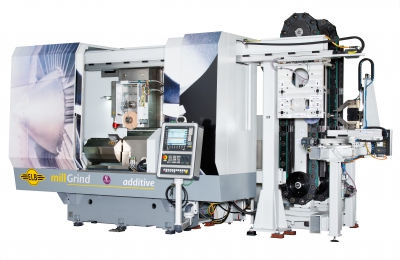
millGrind is a hybrid machine for additive machining. It combines grinding, milling and the option of laser deposition welding in a single machine, saving not only equipment costs, but also valuable changing and retooling time. The optional laser head can also be conveniently exchanged into the machine via a toolchanger in order to realize the functions of laser hardening, marking and additive material deposition welding.
“Our hybrid machine has been on the market for one year now and has already achieved very good results with customers in terms of additive manufacturing support,” says Dr. Markus Stanik, managing director of Elb-Schliff Werkzeugmaschinen GmbH.
The experts from Elb-Schliff see the machine being used primarily in the aerospace and supplier industry as well as for tool and mold making, where specific components are pre-machined in a first step and then ground. Dr. Stanik is familiar with the advantages the process offers: “Laser deposition welding is a very accurate and quick method for
metal welding and thus, of course, particularly suitable for precision components in aircraft manufacturing. The two manufacturing processes thus perfectly complement each other on a hybrid CNC machine.”
Grinding is particularly economical where difficult materials such as those containing nickel and its superalloys must be machined. millGrind uses conventional abrasives with superabrasive capabilities; the XYZ resolution is 0.1 micron. “Hybrid machining helps us boost additive manufacturing to a new level of precision,” says the Elb-Schliff managing
director.
Related Glossary Terms
- computer numerical control ( CNC)
computer numerical control ( CNC)
Microprocessor-based controller dedicated to a machine tool that permits the creation or modification of parts. Programmed numerical control activates the machine’s servos and spindle drives and controls the various machining operations. See DNC, direct numerical control; NC, numerical control.
- gang cutting ( milling)
gang cutting ( milling)
Machining with several cutters mounted on a single arbor, generally for simultaneous cutting.
- grinding
grinding
Machining operation in which material is removed from the workpiece by a powered abrasive wheel, stone, belt, paste, sheet, compound, slurry, etc. Takes various forms: surface grinding (creates flat and/or squared surfaces); cylindrical grinding (for external cylindrical and tapered shapes, fillets, undercuts, etc.); centerless grinding; chamfering; thread and form grinding; tool and cutter grinding; offhand grinding; lapping and polishing (grinding with extremely fine grits to create ultrasmooth surfaces); honing; and disc grinding.
- hardening
hardening
Process of increasing the surface hardness of a part. It is accomplished by heating a piece of steel to a temperature within or above its critical range and then cooling (or quenching) it rapidly. In any heat-treatment operation, the rate of heating is important. Heat flows from the exterior to the interior of steel at a definite rate. If the steel is heated too quickly, the outside becomes hotter than the inside and the desired uniform structure cannot be obtained. If a piece is irregular in shape, a slow heating rate is essential to prevent warping and cracking. The heavier the section, the longer the heating time must be to achieve uniform results. Even after the correct temperature has been reached, the piece should be held at the temperature for a sufficient period of time to permit its thickest section to attain a uniform temperature. See workhardening.
- micron
micron
Measure of length that is equal to one-millionth of a meter.
- milling
milling
Machining operation in which metal or other material is removed by applying power to a rotating cutter. In vertical milling, the cutting tool is mounted vertically on the spindle. In horizontal milling, the cutting tool is mounted horizontally, either directly on the spindle or on an arbor. Horizontal milling is further broken down into conventional milling, where the cutter rotates opposite the direction of feed, or “up” into the workpiece; and climb milling, where the cutter rotates in the direction of feed, or “down” into the workpiece. Milling operations include plane or surface milling, endmilling, facemilling, angle milling, form milling and profiling.
- superalloys
superalloys
Tough, difficult-to-machine alloys; includes Hastelloy, Inconel and Monel. Many are nickel-base metals.
- toolchanger
toolchanger
Carriage or drum attached to a machining center that holds tools until needed; when a tool is needed, the toolchanger inserts the tool into the machine spindle. See automatic toolchanger.






